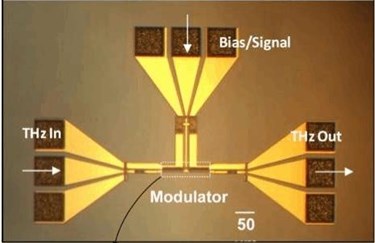Tufts Researchers Build A Chip-Sized, High-Speed Terahertz Modulator
By Jof Enriquez,
Follow me on Twitter @jofenriq

Researchers at Massachusetts-based Tufts University School of Engineering have built a chip-sized, low-power, high-speed modulator operating at above 14 gigahertz, with the potential to work at above 1 terahertz (THz) on the electromagnetic spectrum. This development could pave the way for next-generation wireless devices transmitting with THz frequencies, which will dramatically increase present data transmission speeds.
Current cellular and Wi-Fi networks rely on microwave frequencies at around one gigahertz. Expanding to higher terahertz frequencies with high-speed data rates of up to 100 Gbit/s is of great interest as available bandwidth is dwindling fast.
However, the so-called "terahertz gap" (the band of frequencies between infrared light and radio waves; roughly defined over a frequency band of 0.1–10 × 1012 Hz) so far has been underutilized because of the dearth of compact, on-chip components, such as modulators, transmitters, and receivers.
Now, Tufts University engineers claim to have a breakthrough with their successful fabrication of an on-chip device that can perform gigahertz-rate amplitude modulation, and switching of broadband terahertz electromagnetic waves confined within a novel slot waveguide with tunable, two-dimensional electron gas.
"A prototype device is fabricated which shows THz intensity modulation of 96% at 0.25 THz carrier frequency with low insertion loss and device length as small as 100 microns. The demonstrated modulation cutoff frequency exceeds 14 GHz indicating potential for the high-speed modulation of terahertz waves. The entire device operates at room temperature with low drive voltage (<2 V) and zero DC power consumption," the researchers wrote in a paper published in Scientific Reports.
Previously-built THz modulators were capable of reaching speeds of only up to a few kilohertz (kHz). The Tufts University team claims to have experimental results showing gigahertz speed modulation of THz waves for the first time.
“This is a very promising device that can operate at terahertz frequencies, is miniaturized using mainstream semiconductor foundry, and is in the same form factor as current communication devices. It’s only one building block, but it could help to start filling the THz gap,” said Sameer Sonkusale, Ph.D., of Nano Lab, Department of Electrical and Computer Engineering, Tufts University, and the paper’s corresponding author, in a news release.
A well-known application for building fast and compact terahertz modulators is to achieve high data rate wireless communication, where an inherently high carrier frequency of THz wave will support much wider signal bandwidth compared to the radio frequency (RF) bands used today, according to the researchers. But wider applications abound, such as in material identification, imaging, wireless communications, chemical and biological sensing.
Other researchers are experimenting with other components to fully realize terahertz communications. These efforts include experimenting with two-dimensional superlattice materials to spur electron oscillations in the terahertz range, designing power splitters with unique waveguide architectures, building special modulators that enable wireless THz waves to be transmitted through existing fiber optic networks, or creating filters capable of separating different frequencies in the terahertz spectrum.
